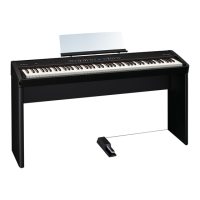Troubleshooting
Problem Cause/Action Page
Two sounds are heard when you play the
keyboard
Could the FP-50 be set to Dual Play? p. 14
When the FP-50 is connected to an external sequencer, set the Local Control to “OFF.” Alternatively, the
sequencer could be set so its Soft Thru feature is o.
p. 41
Pressing the [E. PIANO], [STRINGS], or
[OTHER] button causes other tones to be
heard
The [E. PIANO], [STRINGS], and [OTHER] buttons can also function in selecting “recommended tones.”
With the factory settings, when you select a song from VIMA TUNES, tones which match the song will be
assigned automatically to the [E. PIANO], [STRINGS], and [OTHER] tone buttons.
–
Eect not applied
When you’re using Dual Play or Split Play, and the two tones use dierent eects, no eect will be applied
to tone 2 (when using Dual Play) or the left-hand tone (when using Split Play).
p. 14
p. 15
Reverberation remains even if you turn o
the Ambience eect
The FP-50’s piano sound faithfully simulates the depth and resonance of an acoustic piano, and this may
give the impression of reverberation even if you’ve turned o the Ambience eect.
–
Sound changes abruptly at a certain note in
the upper range
On an acoustic piano, the top one and a half octaves of notes will sound until they decay naturally,
regardless of the damper pedal. The tone quality of these notes will also be dierent.
FP-50 faithfully simulate this characteristic of acoustic pianos. The range that is unaected by the damper
pedal will change depending on the Transpose setting.
–
A “whining” noise is heard
If you hear this in headphones:
Some brilliant and sharply dened piano sounds contain signicant high-frequency components, which
may sound like a metallic resonance has been added. This is due to the faithful simulation of a piano’s
actual characteristics, and does not indicate a malfunction.
You can adjust this resonance by editing the following settings.
• String Resonance setting (p. 38)
• Ambience Depth setting (p. 17)
If you don’t hear this in headphones:
Some other reason may be responsible (e.g., resonance in the FP-50 itself). Please contact your dealer or
Roland Service Center.
–
Something wrong with low-frequency
sounds/Buzzing resonance occurs
If you don’t hear this in headphones:
Performing at high volumes may cause the speakers or objects near the FP-50 to resonate. It is also
possible for uorescent lights or glass doors in the room to resonate. For the low notes in particular, this is
more likely to occur at high volume. To minimize such resonance, take the following measures.
• Locate the speakers 10–15 cm away from the wall.
• Lower the volume.
• Move the resonating object farther away.
If you hear this in headphones:
Some other reason may be responsible. Please contact your dealer or Roland Service Center.
–
At high volumes, the sound may be distorted due to the way in which you are playing. If so, adjust the
equalizer settings or reduce the volume.
p. 8
p. 17
Song does not play correctly
Problem Cause/Action Page
Can’t play a song
Is the data format compatible with the FP-50?
To be playable, audio les must be in the following format.
• SMF formats 0/1
• Roland Piano Digital format (i-format)
• Audio les: WAV format, 44.1 kHz, 16-bit linear
–
Song tempo is unstable
If there is an excessive amount of performance data when playing a song from a USB ash drive, the
tempo might become unstable.
–
Can’t see the song names on USB ash drive
If the song name data in the le is blank or consists only of spaces, the song name will not be displayed. –
Is the le name extension “MID”?
If the le name extension is wrong, the le cannot be handled as song data.
–
Song names that contain characters other than letters, numbers, and certain symbols will not be
displayed properly.
–
Can’t play back a song saved on USB ash
drive
Is the le name extension “MID”?
If the le name extension is wrong, the le cannot be handled as song data.
–
Can’t record
Problem Cause/Action Page
Can’t record audio
Is a USB ash drive connected to the USB MEMORY port?
In order to use audio recording, you must connect a USB ash drive (sold separately) to the USB MEMORY
port.
p. 25
47
Operation Guide Getting Ready Performing Recording Registrations Settings
Appendix

